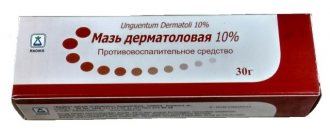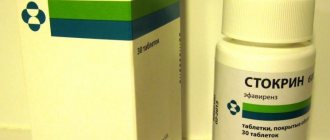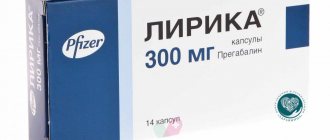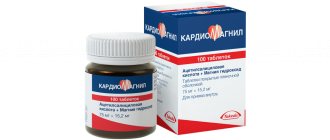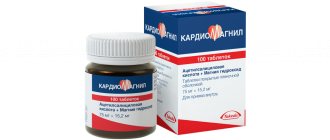Indications
Ministry of Health of Russia
- Manic and hypomanic states of various origins
- Prevention and treatment of affective psychoses
- Prevention and treatment of affective disorders in patients with chronic alcoholism
- Migraine, Meniere's syndrome, sexual disorders, drug addiction.
FDA recommendations
- Manic states in manic-depressive illnesses
- Prevention of manic states
UK Medicines and Healthcare Products Regulatory Agency guidelines
- Manic and hypomanic episodes
- Depressive episodes when antidepressants have not worked
- Preventing exacerbation of bipolar disorder
- Aggressive behavior
Treatment regimen
Dosage and dose selection
Required plasma concentration level:
Mania: 1.0-1.5 mEq/L Depression: 0.6–1.0 mEq/L Maintenance dose: 0.7–1.0 mEq/L
Treatment should begin with a dose of 300 mg 2-3 times a day.
How quickly does it work?
Response to acute mania may occur within 7-14 days.
Therapeutic effect: 1-3 weeks.
Expected Result
Disappearance of symptoms.
If it doesn't work
Check the level of the substance in the blood;
Increase the dose;
Switch to another drug or add another drug;
Connect psychotherapy;
Determine if there is a comorbid condition
How to stop taking it
Reduce dose over three months. If taken abruptly, the risk of suicide may increase [1].
Treatment combinations
- Valproic acid
- Atypical antipsychotics
- Lamotrigine
- Antidepressants (with caution, as there is a risk of mood destabilization) [1].
Use during pregnancy
Can pregnant women use products that contain lithium? A drug based on the substance in question can become dangerous to the developing fetus. For example, such medications provoke the development of heart defects in a child. If, however, drugs containing lithium are indicated for use by a pregnant woman, then it is important to constantly be under the supervision of the attending physician, who will be able to monitor the concentration of this substance in the plasma. If this is not done, the baby may be diagnosed with hypotension or goiter.
Next, we will look at some lithium drugs, the names of which you can find in pharmacies and in the prescriptions of your attending physicians.
Cautions and contraindications
- Toxic levels of the substance are easily achieved. Signs of intoxication: tremor, ataxia, diarrhea, vomiting, sedation
- You need to watch for signs of dehydration; if there are signs of infection, sweating, diarrhea, reduce the dose
- Closely monitor patients with thyroid disease
- If you experience unexplained syncope and palpitations, you should consult a cardiologist
- Lithium is contraindicated if the patient has: severe kidney disease, severe cardiovascular disease, Brugada syndrome, dehydration, hyponatremia, allergy to lithium.
Special patient groups
Patients with kidney problems
Not recommended for patients with renal failure [1].
Patients with liver disease
Use in normal dosage [1].
Patients with heart disease
Not recommended for patients with serious heart disease [1].
Elderly patients
To achieve therapeutic concentrations of lithium in the blood, low doses are sufficient for elderly patients [1].
In older people, side effects are more pronounced.
Neurotoxic effects, including delirium, may occur even at therapeutic doses in susceptible elderly patients.
Often an adequate plasma lithium concentration for the elderly is <0.6 mEg/L [1].
Children and teenagers
- Efficacy and safety in children under 12 years of age have not been proven [1].
Pregnant
- An increased risk of fetal development defects has been proven (2-3 times), although less than that of other mood stabilizers (valproic acid) [1].
- The risk of abnormalities in the development of the child’s heart has been proven
- If lithium treatment is continued, blood levels should be assessed every four weeks, starting every week from the 36th week.
- Morning sickness in pregnant women increases lithium levels in the blood.
- Taking lithium during labor causes hypotension in the baby; It is recommended to stop taking lithium 24-48 hours before delivery
- During childbirth, it is important to monitor fluid balance
- After birth, monitor for 48 hours for signs of muscle hypotension.
- The use of lithium in women planning pregnancy requires a balanced approach with an assessment of all risks
- Lithium should be discontinued during pregnancy by gradually reducing the dose
- Given the risk of relapse, lithium should be resumed immediately after delivery
- It is better to use atypical antipsychotics during pregnancy instead of lithium
- Bipolar disorder symptoms may worsen during pregnancy
Breast-feeding
- It is recommended that you stop taking lithium or stop breastfeeding
Lithium preparations
Share with friends
Lithium preparations are psychotropic drugs from the group of mood stabilizers. These are historically the first drugs of this group, discovered in 1949; however, they remain of utmost importance in the treatment of affective disorders, primarily manic and hypomanic phases of bipolar disorder, as well as in the prevention of its exacerbations and for the treatment of recurrent and resistant depression. Lithium preparations have other applications.
Lithium is an alkali metal, therefore in medicine it is used in the form of salts, mainly in the form of carbonate (regular and prolonged action), but also in the form of other salts: hydroxybutyrate (“Oxybate”) and nicotine salt (“Litonite”), and also citrate, succinate, orotate, sulfate and lithium chloride (which are not used in the Russian Federation).
For the first time, lithium salts were used to treat affective disorders by ancient physicians. They discovered their qualities empirically, using mineral waters with high concentrations and had no scientific understanding of their biochemical properties. There are references to ancient Roman doctors using alkaline mineral waters containing lithium from springs in Northern Italy to treat patients who were in a state of “agitation” or “euphoria.” For example, in the 2nd century AD. e. The Roman physician of Greek origin, Soranus of Ephesus, recommended “natural waters, such as alkaline springs” for the treatment of “mania.” Around the same time, another physician, Galen, prescribed them as baths for a similar purpose. In the 5th century, Caelius Aurelian, in his Latin translation of Soranus of Ephesus’s book “On Acute and Chronic Diseases” (Latin: De morbis acutis et chronicis), also writes about this method of treating mania. In medieval Europe, some springs were believed to have special properties. The springs in St Fillans, a mountain village in Scotland, were especially famous. Modern scientists have found that they contain a high concentration of lithium. Lithium salts were first used in scientific medicine in 1859 to treat gout because they increase the solubility of uric acid crystals in the laboratory. However, the levels of lithium in the body required for this were found to be toxic. However, the idea that lithium helps dissolve urate, the accumulation of which in the body was believed to be the cause of many diseases, led to the development of many "tonics"; the most famous of them is 7 Up, which appeared in 1929 under the name Bib-Label Lithiated Lemon-Lime Soda, from which lithium citrate was excluded only in 1950, after its use was banned in the United States. In 1949, in Australia, John Cade, exploring the hypothesis that manic-depressive illnesses are caused by intoxication with some product of natural metabolism, conducted experiments with injections of urine from patients into the abdominal cavity of guinea pigs: the technical capabilities for experiments were then small - Cade's laboratory was a converted barn on the grounds of a hospital - but the very fact of animal research in psychiatry in the 1940s was an outstanding phenomenon. Assuming that the harmful effects of such injections were caused by uric acid, he proceeded to experiment with this compound and, in an attempt to increase its solubility in water, added lithium uric salt to the samples (repeating the gout treatment). At the same time, the toxic effect of the injections decreased sharply. Subsequent experiments showed that injections of lithium carbonate had a strong calming effect on animals. After testing lithium on himself (to show its safety in humans), Cade began conducting small-scale studies of the effects of lithium (citrate and carbonate) on some of his patients diagnosed with mania, schizophrenia and depression, and in the case of mania, he obtained outstanding results. The calming effect was so strong that Cade theorized that mania was caused by a lithium deficiency in the body. Although Cade's results were extremely promising, the side effects of lithium drugs caused serious problems. The use of lithium salts as table salt substitutes in the low-salt diet of hypertensive patients (at dosages of up to 14 grams per day) resulted in the death of four patients, and following these tragic incidents, the use of lithium in the United States was banned by the FDA in the same year in which its therapeutic discovery action; the ban remained in effect until 1970. In addition, as a natural material, lithium salts could not be patented in order to obtain and exploit the exclusive right to them, which led to a significant delay in the spread of lithium preparations in pharmacology.
Lithium has a variety of effects on the nervous system, in particular acting as an antagonist of sodium ions in nerve and muscle cells. Thus, it weakens the conduction of nerve impulses (this also explains one of the common side effects of lithium drugs: muscle weakness). Lithium also affects the metabolism and transport of monoamines (norepinephrine, serotonin), and increases the sensitivity of some areas of the brain to dopamine. According to some data, the main role in the mechanism of action of lithium is played by its ability to block the activity of enzymes involved in the synthesis of inositol, which plays a certain role in regulating the sensitivity of neurons. In addition, it has been found that during mania there is an irregular increase in the activity of protein kinase C (eng. PkC), and a recent study showed that lithium, like another well-known mood stabilizer, sodium valproate, inhibits its activity, and on the other hand, new PkC inhibitors exhibit antimanic properties. The basis of lithium ion therapy for bipolar disorders is their ability to relatively selectively inhibit glycogen synthase kinase 3 (GSK-3) by competing with magnesium ions.
First of all, lithium preparations are used to treat manic and hypomanic states of various origins (especially with frequent attacks). They are also widely used for the prevention and treatment of affective psychoses (bipolar, schizoaffective). When depression is resistant to antidepressant therapy, adding lithium to treatment often has a beneficial effect. There is evidence of the effectiveness of lithium not only in endogenous psychoses, but also in patients suffering from organic psychoses, epilepsy, phasic affective fluctuations that do not reach the level of bipolar disorder. In addition, lithium preparations are used for the prevention and treatment of affective disorders in patients with chronic alcoholism. Lithium carbonate has been successfully used to correct neutropenia during radiation therapy for lymphogranulomatosis. Lithium salts cause increased proliferation of white blood cells in the bone marrow and can be used for leukopenia. For agranulocytosis, they are used instead of Mercazolil for the treatment of hyperthyroidism. In addition, lithium therapy significantly slowed the progression of ALS in a recent Italian study of 44 patients; To date, no other treatment has been able to achieve such remarkable success. The external use of lithium salts for dermatological diseases, such as viral infections, fungal diseases, seborrheic dermatitis and even malignant tumors is of interest. Currently, lithium succinate is used for external use.
In classic mania, lithium preparations have the most pronounced therapeutic effect; they are less effective in “mixed” conditions, and with rapid cycling, a positive effect is achieved perhaps only in 22-30% of patients. In patients suffering from phase depression as part of bipolar disorder, lithium given alone has a modest antidepressant effect, but other patients with depression have little response to this drug unless antidepressants are co-administered. However, adding lithium to antidepressant treatment dramatically reduces relapses of depression. For depression that is resistant to the use of antidepressants, it has been established with a high degree of certainty that the addition of lithium preparations to therapy (at a dose of about 800 mg/day or when a plasma concentration of at least 0.5 mmol/l is achieved and a treatment duration of at least two weeks) leads to to increase the effectiveness of therapy by more than three times, and in absolute numbers, improvement occurs in 27% of patients. According to a meta-analysis, lithium drugs for these depressions are equally effective compared to atypical antipsychotics, but their treatment is cheaper. It is believed that the effectiveness of lithium therapy for depressive states is manifested in the treatment not so much of depressive affect, but of mixed affect, that is, if the structure of the depressive syndrome contains inclusions of manic phases. For all mood disorders, treatment with lithium significantly reduces the incidence of suicide, this was confirmed by a meta-analysis of 48 randomized trials. This occurs not only by treating the disease, but also because lithium reduces aggressiveness and possibly impulsivity. When treated with lithium, the incidence of suicide is reduced compared to treatment with other drugs, and overall mortality also decreases. The risk of suicide with lithium use is reduced fivefold.
Pharmacokinetics
Lithium salts are quickly absorbed after oral administration and dissociate in the body. Lithium ions are detected in various organs and tissues 2-4 hours after a single dose. They are excreted by the kidneys, and this process depends on the concentrations of sodium (and potassium) ions: if there is insufficient amount of sodium in the body, lithium is reabsorbed in the renal tubules and its concentration in the blood is maintained. With an excess of sodium (or potassium), the excretion of lithium increases. Therefore, during the treatment process, it is important to maintain a normal water-salt balance, and table salt serves as a natural antidote for excessive lithium concentrations. The half-life of lithium salts from the body varies over time, remaining on average individually stable (except in cases of lack of salt, dehydration (dehydration), use of diuretics and similar dangerous situations).
Lithium ions have a “threshold” effect, that is, below a certain threshold concentration they do not affect the pathological process. The minimum therapeutic concentration is 0.6 mmol/L (millimoles per liter), and the maximum permissible concentration is 1.6 mmol/L , thus the therapeutic breadth of lithium preparations is extremely low; in practice, it is not recommended to exceed a concentration of 1.2 mmol/l. Preventive concentrations may be lower: 0.2-0.3-0.4 mmol/l , however, they can also cause unpleasant side effects. Because the rate of elimination of lithium varies among patients, dosages should be individualized based on measurements of plasma lithium concentrations. The most informative examination is carried out 10 hours after taking the last dose of lithium; Usually the examination is carried out 8-12 hours later (in the morning on an empty stomach after taking the last evening dose), or 24 hours after taking the only morning dose. At the beginning of treatment, measurements of lithium concentration should be carried out at least once a week, subsequently - once every 2 weeks or monthly. During preventive therapy, measurements are taken every few months.
When an objective measurement of blood lithium concentration is not available, the dosage is determined according to clinical signs: The lithium dosage should be increased gradually. In case of increasing side effects (primarily tremor, nystagmus, incoordination, dysarthria, heart rhythm disturbances), it is necessary to take a break in treatment for 1-2 days and refrain from further increasing the dose of the drug. Once a favorable therapeutic effect is achieved, the dosage should not be increased. In such cases (in the absence of objective control of concentration), the dosage should not exceed 2.1 g per day (calculated as carbonate).
The use of lithium for psychotic disorders usually begins with 0.6-0.9 g / day (carbonate). If well tolerated, 1.2 g is prescribed on the second day, and the dose is increased daily by 0.3 g, to a daily dose of 1.5-2.1 g. If necessary, the dosage can be increased to 2.4 g / day (with mandatory blood control). In doses above 2 g per day, the drug is not recommended for use for more than 1-2 weeks. Elderly patients should be prescribed lithium in lower doses than younger patients. After the disappearance of psychotic symptoms, the dosage is gradually reduced to 1.2-0.6 g per day. In case of recurrence of psychotic phenomena, the dosage is again increased to an effective level. 7-10 days after the full therapeutic effect is achieved again, the dose is again gradually reduced. Then the drug is discontinued or continued to be prescribed for preventive purposes from 0.3 to 1.2 g/day. The concentration of lithium ions in the blood plasma should not exceed 1.2 mmol/l. Lithium can be prescribed 2 times a day; however, taking lithium once a night reduces its toxic effect on the kidneys. According to other data, the daily dose should be divided into 3-4 doses, which reduces fluctuations in lithium levels and side effects associated with concentration peaks. Tolerance to lithium improves when given after meals. Prolonged forms are prescribed 1-2 times a day. The tolerability of lithium when using long-acting forms improves (less incidence of gastrointestinal disorders and tremors), but the time of exposure to the kidneys is prolonged.
The patient should be aware of the need to follow a diet: avoid consuming large amounts of liquid and salt, limiting foods rich in lithium (smoked meats, some types of hard cheeses, red wine). Before prescribing long-term lithium therapy, it is advisable to have the following examination data in order to avoid toxic effects: a clinical blood and urine test, and in patients over 40 years of age, ECG data. Also, if possible, a Zimnitsky concentration test is performed to determine the level of creatinine, total thyroxine (T4), thyroid-stimulating hormone (TSH), antithyroid antibodies, BUN and blood electrolytes. Patients on maintenance therapy should be examined by a doctor every 3-6 months; in this case, the content of lithium, sodium, potassium in the blood should be determined, and, if possible, also thyroxine and TSH, antithyroid antibodies, BUN and creatinine, and the concentration function of the kidneys should be examined (using the Zimnitsky test). The frequency of tests depends on the values obtained and the patient’s condition. Some consider annual determination of creatinine clearance sufficient. Because the concentration of lithium in the blood depends on the concentration of sodium, blood lithium testing should be performed more frequently in patients on a low-salt diet or receiving diuretics.
Drugs that affect renal function may affect serum lithium concentrations, and even small increases in lithium concentrations can be dangerous because the therapeutic range of lithium is narrow. Lithium does not affect the activity of liver enzymes and does not undergo biotransformation and is excreted unchanged from the body.
List of interactions with other drugs
- Neuroleptics. Lithium, if necessary, can be prescribed simultaneously with antipsychotics. There is evidence that when it is combined with antipsychotics, reversible neurotoxicity sometimes occurs in middle-aged and elderly people. However, this drug combination is quite safe and effective if antipsychotics and lithium are used in moderate doses and the patient is closely monitored; however, this combination of drugs should be discontinued as soon as the therapeutic effect of lithium is achieved. When antipsychotics and lithium are combined, encephalopathy is possible - most often it developed when combined with haloperidol, but has also been described when combined with thioridazine, perphenazine and thiothixene. Extrapyramidal side effects and hyperkinesia are also possible; There have been cases of a clinical picture resembling neuroleptic malignant syndrome.
- Carbamazepine (“Finlepsin”). In most cases, the combination of carbamazepine and lithium is well tolerated, but in patients at risk (with signs of the neurotoxic effect of lithium or with a history of neurological diseases), symptoms of a neurotoxic effect are possible even against the background of average drug concentrations in the blood.
- Tricyclic antidepressants (amitriptyline, etc.). Rare cases of seizures have been described when combining high-dose amitriptyline and lithium, as well as cardiovascular complications and hypothyroidism while taking lithium and tricyclic antidepressants for more than six months. There is evidence of the occurrence of signs of a neurotoxic effect in the form of tremor, memory impairment, distractibility, and disorganization of thinking even with normal lithium concentrations in the blood and average doses of amitriptyline. In a number of patients, serotonin syndrome was diagnosed with a combination of lithium and clomipramine.
- Antidepressants are selective serotonin reuptake inhibitors (fluoxetine, etc.). The combination of lithium with antidepressants of this group is usually well tolerated, but cases of serotonin syndrome have sometimes been reported. Combination with lithium may enhance both the antidepressant and toxic effects of fluoxetine.
- Dopaminergic drugs . Against the background of a combination of lithium and levodopa, the development of dyskinesias and hallucinations is possible; when combined with methyldopa, neurotoxic side effects may develop disproportionately to the concentration of lithium in the blood plasma.
- Thyroid hormones. When lithium is combined with thyroxine or liothyronine, the release of thyroid hormone is reduced.
- Diuretics (“diuretics”) . When combined with thiazide diuretics (for example, hydrochlorothiazide), lithium excretion decreases and its serum concentration increases, which can lead to lithium intoxication. Potassium-sparing diuretics are safer; Data on the combination of lithium with loop diuretics and carbonic anhydrase inhibitors are contradictory. Lithium is sometimes combined with a potassium-sparing or thiazide diuretic to reduce lithium-induced polyuria or nephrogenic diabetes insipidus.
- Non-steroidal anti-inflammatory drugs, antibiotics (metronidazole, tetracyclines) . Serum lithium concentration increases. Ketorolac is incompatible with lithium preparations.
- Theophylline, aminophylline . Serum lithium concentration decreases.
- Cardiac glycosides (digitoxin, etc.) . This combination is not recommended due to the increased toxic effects of lithium and the development of arrhythmias.
Even when the correct therapeutic or prophylactic (“maintenance”) concentrations of lithium in the body are maintained, the side effects can be severe. The most common and unpleasant symptoms are tremor of the fingers, dizziness, drowsiness, feeling of fatigue, muscle weakness, thirst and polyuria. However, it should be noted that the objectively positive changes with lithium therapy (if it is successful) far outweigh the negative impact of possible side effects. Prophylaxis with lithium in patients with bipolar disorder often leads to a radical change in the lives of these patients. Affective episodes (mania and depression) weaken, become less frequent, or even disappear completely. This has a positive effect on performance, socialization, and overall quality of life. The situation of patients becomes more stable and safe, the expectation of deterioration and hospitalization disappears.
Information about side effects is intended primarily for the doctor. It is not at all necessary that the drug will cause the listed undesirable effects, however, if they occur, they may be caused precisely by the action of the drug. In this case, the psychiatrist may decide to reduce the dosage, discontinue the drug, or replace it. With varying frequencies (from “frequent”: up to tens of percent to “very rare”: a few cases per 100 thousand prescriptions), the following side effects are observed during lithium therapy:
- From the central nervous system and peripheral nervous system: fine tremor of the hands, muscle weakness and fatigue, muscle twitching, slowness, lethargy, drowsiness, dizziness, rough tremor, ataxia, muscle hypertonicity, increased deep tendon reflexes, hyperextension of the limbs, confusion, stupor, epileptiform seizures, articulation disorders, deterioration in concentration, headaches, visual hallucinations, early extrapyramidal disorders (lithium does not cause tardive dyskinesia), benign intracranial hypertension (false brain tumor). In patients who have been taking lithium for a long time for preventive purposes, the so-called phenomenon of “automatic existence” has been described: patients may complain of dulling of emotions, a feeling of depersonalization, a feeling of “grayness” of emotional sensations or loss of creative abilities, and sometimes memory deterioration and difficulty in perception. It is difficult to quantify these complaints because some may reflect resolution of symptoms of hypomania or symptoms of mild depression, or may be due to aging (although lithium may also impair performance on some cognitive tests).
- From the cardiovascular system: heart rhythm disturbances.
- From the endocrine system : nephrogenic diabetes insipidus, non-toxic goiter, hypothyroidism (in 5-30% of patients constantly taking lithium for 6-18 months, more often in women and in the form with frequent attacks), the occurrence or intensification of hypothyroidism in Hashimoto's thyroiditis .
- From the gastrointestinal system: nausea (especially in the first days of treatment), anorexia, vomiting, diarrhea, indigestion or abdominal pain, dyspepsia.
- From the genitourinary system: interstitial fibrosis (most often with repeated episodes of lithium intoxication and with long-term use of lithium in combination with antipsychotics), kidney necrosis, decreased libido.
- Skin reactions: acne, psoriasis, maculopapular rash, folliculitis, exfoliative dermatitis.
- Other: increased thirst, polyuria, skin irritation, hematopoietic disorders, leukocytosis, increased body weight, edema of the lower extremities or face.
Many of the side effects are mild, occur in the initial stages of treatment and gradually disappear, other side effects may progress as treatment continues, which may require, accordingly, the replacement of lithium drugs with other mood stabilizers, for example, valproate or quetiapine. As a rule, a rapid increase in the concentration of lithium in the blood portends the occurrence of side effects, especially from the gastrointestinal tract.
In case of overdose, lithium acts primarily on the central nervous system and the kidneys; overdose relatively often ends in death. Most often, the first manifestations of intoxication are increased deep tendon reflexes and muscle twitching. An overdose is manifested by a metallic taste in the mouth, thirst, severe tremor, dysarthria, ataxia, often by confusion, anxiety, drowsiness and slurred speech, with further increase in intoxication - fascicular muscle twitching, myoclonus, convulsions, coma. The longer the toxic level of lithium in the blood persists, the greater the likelihood of irreversible changes in the central nervous system, and in especially severe cases, death. Lithium intoxication resembles clinical signs of intoxication resulting from an overdose of barbiturates; death occurs from secondary respiratory depression with subsequent complications. If you suspect symptoms of intoxication, you should stop taking lithium and immediately measure its concentration in the blood plasma.
It consists of maintaining basic physiological parameters and good hydration. The biological half-life of lithium in the human body is 24 hours, and adequate treatment throughout the day keeps the patient alive until the kidneys begin to excrete lithium at a predictable rate. Treatments for overdose such as increasing lithium excretion with aminophylline or urinary alkalization have not yielded encouraging results. In cases where an overdose threatens death, renal hemodialysis is resorted to, but intoxication is rarely so significant as to necessitate this procedure.
Impaired renal excretory function; Addison-Beermer disease; cardiovascular diseases in the stage of decompensation, cardiac conduction disorders; pregnancy; lactation; leukemia; thyroid dysfunction; diabetes mellitus and diabetes insipidus; acute decompensation of chronic liver diseases; peptic ulcer; cataract; osteoporosis; acute infectious diseases; age up to 15 years.
The use of lithium in the first trimester of pregnancy (as well as some other mood stabilizers: valproate, carbamazepine) leads to an increased risk of severe birth defects: for example, Ebstein's anomaly (right ventricular hypoplasia and tricuspid valve insufficiency). In each case of pregnancy in a patient with bipolar affective disorder, the risk of using or not using drug therapy should be assessed. The effect of lithium during breastfeeding on a child's growth and development is unknown, so breastfeeding while taking lithium is not recommended.
According to research, after stopping lithium, manic or depressive episodes may return, even if the condition has been stable for a year. Manic states are more likely to occur after suddenly stopping lithium use. In more than half of patients, relapses of mania occur within 3 months after discontinuation of lithium; relapses of depression usually begin later. In 50% of patients, the phases resume more often than before the start of treatment: apparently, after abrupt withdrawal of the drug, a rebound effect occurs. With gradual withdrawal of lithium (over 2-4 weeks), the risk of early relapses decreases. If side effects do not require faster withdrawal, it is recommended to reduce lithium intake by no more than 300 mg per month. Rapid withdrawal of lithium leads to an increased risk of suicide. It was believed that after discontinuation of lithium, immunity to it may occur with repeated use, but studies do not support this opinion.
Lithium carbonate is used primarily as a medicine, sometimes in the form of prolonged-release preparations.
- Mashkovsky M.D. Medicines. — 15th ed. - M.: Novaya Volna, 2005. - P. 109-111, 763. - 1200 p. — ISBN 5-7864-0203-7
- Nuller Yu. L., Mikhalenko I. N. Side effects of lithium drugs // Affective psychoses. - L.: Medicine, 1988. - 264 p. — ISBN 5-225-00187-4
- Tiganov A. S., Snezhnevsky A. V., et al. General psychiatry // Guide to psychiatry / Ed. Academician of the Russian Academy of Medical Sciences A. S. Tiganov. - M.: Medicine, 1999. - T. 1. - 712 p. — ISBN 5-225-02676-1
- Avrutsky G. Ya., Neduva A. A. Treatment of mentally ill patients. — 2nd ed. - M.: Medicine, 1998. - 528 p. — ISBN 5-225-00052-5
Wikipedia
Share with friends
Interaction with other substances
- Non-steroidal anti-inflammatory drugs, including ibuprofen, as well as diuretics and ACE inhibitors may increase lithium levels in the blood, therefore, they should be used with caution if the patient's condition has been stabilized on a certain dose of lithium
- Metronidazole increases lithium toxicity
- Acetazolamide, alkalis, xanthine and urea reduce lithium levels
- Methyldopa, carbamazepine and phenytoin may increase lithium toxicity
- Use calcium antagonists with caution as they may increase lithium toxicity
- SSRIs may increase the likelihood of dizziness, confusion, agitation, diarrhea, and tremors
- Haloperidol with lithium may lead to encephalopathic syndrome
History of formation
Even in ancient times, healers noticed the calming effect of alkaline waters from certain mineral springs. Scientific medicine discovered lithium salts as a remedy for gout in 1859. It was found that when taking lithium, the solubility of uric acid crystals increases, but the use has toxic consequences.
Australian scientist John Cade in 1949 injected the urine of psychotics with lithium salts into the abdominal cavity of guinea pigs and unexpectedly discovered a sharp decrease in the toxic effect. He extended this experiment on some of his patients with mental disorders and obtained good results. This experience gave him reason to believe that lithium deficiency was the cause of manic states.
Li salts began to be used as substitutes for table salt for hypertensive patients. The side effects of the metal on the human body still led to the death of four patients. The United States immediately banned lithium products and began using them again only in 1970.
Tests during treatment
Before starting treatment: check the functions of the kidneys and thyroid gland, patients over 50 - ECG;
Repeat kidney function checks 1-2 times a year;
It is necessary to measure the level of lithium in the blood frequently (12 hours after the last dose; for the treatment of an acute condition, the indicator should be 1.0-1.5 mEq/L, for a chronic condition 0.6-1.2 mEq/L.
At the beginning of treatment, lithium levels are monitored every 1-2 weeks until the desired concentration is achieved; then every 2-3 months for six months, then every 6-12 months.
You need to check your lithium level a week after changing the dose, after changing the course of the disease, after changing the treatment combination.
Since lithium often leads to weight gain, the patient's body mass index should be determined before starting treatment.
Before starting treatment, it is necessary to find out whether the patient has prediabetes, diabetes, or dyslipidemia in order to take these factors into account during treatment.
Side effects and other risks
Mechanism of side effects
The causes of lithium side effects are unknown and complex.
Side effects
- Ataxia, dysarthria, delirium, tremor, memory problems
- Polyuria, polydipsia
- Diarrhea, nausea
- Dangerous side effects: lithium poisoning, renal failure, renal diabetes insipidus, arrhythmia, bradycardia, hypotension, T wave flattening or inversion
- Weight gain: yes, and can be significant
- Sedation: yes, and can be significant
What to do about side effects
- Wait;
- Reduce dose;
- Take the entire dose in the evening;
- Take not 3 times a day, but 2 times a day;
- To avoid irritation to the stomach, take with food;
- To avoid tremors, give up coffee;
- Propranalol (20–30 mg 2–3 times a day) will help relieve tremor;
- Switch to another drug [1].
Long term use
Prescribed for long-term use
addictive
No.
Overdose
May be fatal; tremor, dysarthria, delirium, coma, convulsions, disorder of the autonomic nervous system.
Bottom line
It is possible to alleviate the condition of patients who suffer from a variety of mental illnesses accompanied by serious emotional disorders thanks to a number of medicines made using lithium salts. Such medications, judging by reviews from experts and real customers, are incredibly effective and help relieve conditions of varying severity. Treatment with drugs from this group should be prescribed by a competent attending physician, who will be able to competently formulate a treatment regimen and later, if necessary, adjust it. You should not make the decision to use lithium on your own. In this case, you can make mistakes that will negatively affect the patient’s condition or provoke lithium poisoning, which sometimes leads to death. It is important to pay sufficient attention to the study of contraindications and possible side effects. This will help to avoid unpleasant surprises or be prepared for any negative reactions from the patient’s body. Constant monitoring by the attending physician will guarantee the successful completion of the prescribed therapy.
Never forget to take care of yourself. Make an effort to choose the best quality drug. Pay sufficient attention to the physical and mental well-being of your loved ones. Be always healthy!
Expert advice
Lithium is a mood stabilizer that works as well as more modern drugs, and for euphoric mania it is the best drug.
In bipolar disorder, manic episodes are treated better than depressive episodes.
Prevents suicide not only in patients with bipolar I disorder, but also with bipolar II disorder and unipolar depression.
Side effects resulting from lithium toxicity occur at therapeutic doses.
For hyperactive, agitated psychotic patients with mania, it is better to use antipsychotics rather than lithium.
An acute attack of mania is best treated with antipsychotics or benzodiazepines or valproic acid. Lithium can be used as a supplement to remain after the acute attack has passed.
Only a third of patients with bipolar disorder improve completely with monotherapy; the rest require combinations of drugs.
The effectiveness of adding lithium to antipsychotics in the treatment of schizophrenia has not been proven.
Mechanism of action
The main pharmacological effect of lithium salts is the activation of the reuptake of free norepinephrine and serotonin by adrenergic endings in the central nervous system, which form the development of affective states. The therapeutic effect reduces the number of b-adrenergic receptors and suppresses noradrenergic activity.
Lithium ions suppress sodium ions in nerve and muscle cells, thereby interfering with the transport of monovalent cations through membranes and weakening nerve impulses.
“Li” blocks the activity of neuronal dehydrogenase enzymes that synthesize inositol, which regulates the sensitivity and cellular respiration of neurons.
Drug therapy "Li" shows the best results in the treatment of mixed affect, when patients have a manic syndrome. In this case, there must be a sufficiently large clear gap between the phases of the cycle, then lithium salts exhibit a stabilizing effect on the patient’s psyche.
